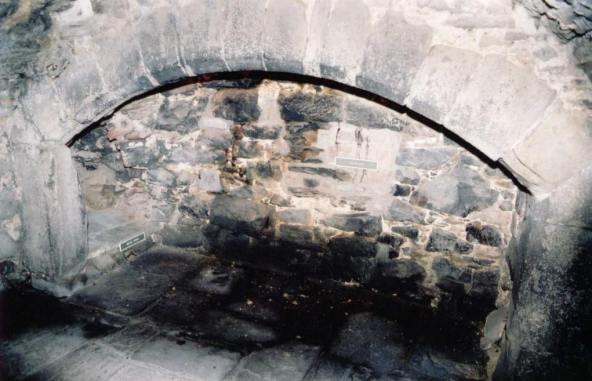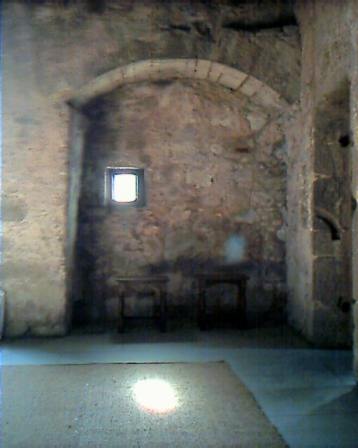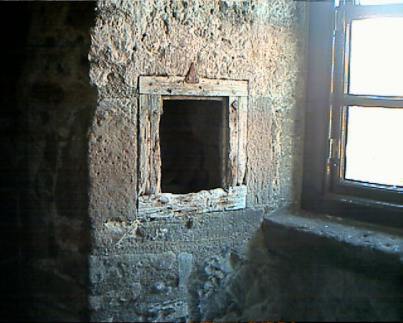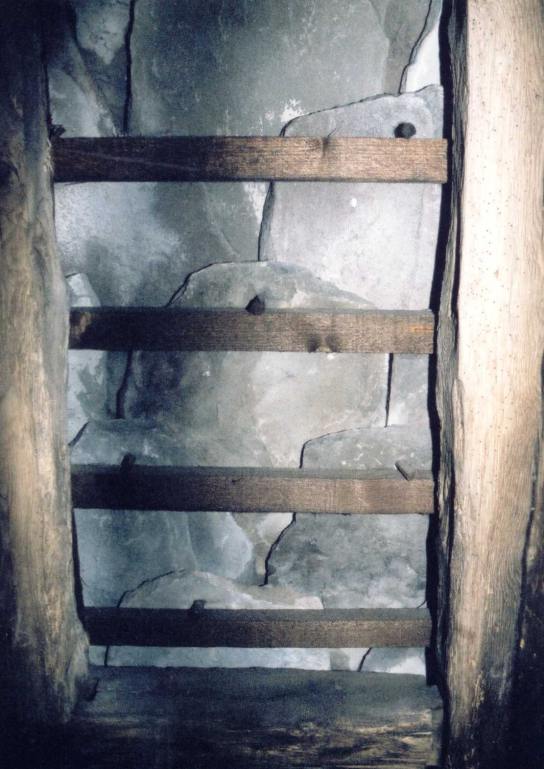
Claypotts Castle
The internal features of the castle

The large fireplace in the castle's kitchen
Although designed to be defensible, Claypotts Castle was also a comfortable home for its owners. The castle's many rooms contain features which tell us a lot about daily life inside the castle.
As you enter the castle's doorway there are two rooms facing you, on the ground floor. These have vaulted (curved) ceilings and gun ports built into the walls, and would have served as storage cellars. These rooms have stone paving slabs on their floors, and they have heavy wooden doors.
A blocked-up gun port in the northern cellar |
Water could be poured through this water channel from outside the walls |
If you turn to the right as you enter the castle, you will come to the kitchen. On the right, just before the kitchen doorway, is a water intake channel, built into the wall, underneath the stairway. Water could be poured through this from outside the castle, and the water would have been collected in a barrel, placed underneath the stone channel. No well has been discovered at Claypotts, but there is a stream nearby.
On the left side of the large kitchen fireplace is a bread oven |
A slop basin is built into the kitchen wall |
The kitchen fireplace is very large, and incorporates a circular bread oven on its left side. To its right, a slop basin has been built into the wall. Liquids poured into it would drain through the wall to the outside.
Climbing the spiral stair leads you to the first floor, where the main hall of the castle is located. This was the centre of family life, and would have been furnished with tables, stools and benches. Although the walls seem bare today, they would probably have been covered with colourful wall-hangings when the castle was lived in. Guests of the castle's owners would have been taken up the main stair to the hall, passing through a servery which used to separate the hall from the staircase. The screens around the servery are now gone, but traces of them can be seen in the walls.

The castle's main hall
There is a large fireplace in the main hall, with a salt box set into its left-hand side. To the right of the fireplace, next to a window, is a small aumbry or wall cupboard.
 Once a servery |
 An aumbry (wall cupboard) in the hall |
The two bedchambers on the first floor are very comfortable rooms, probably used by the owner and his family. The bedchamber entered directly from the main hall is probably when the castle's owner slept. This room now has a large, wooden four-poster bed in it. Facing the bed is the fireplace. A tall cupbard just inside the doorway to this room (on the left) was probably once a latrine (toilet) before being fitted with shelves and used as a cupboard. Another cupboard at the opposite side of the room was probably used to store valuables.
A small area of painted plasterwork survives on the wall, near the window on the far side of this room.
Once a latrine (then a cupboard) |
The painted plaster |
The room above the main hall, on the second floor, was once divided to form two rooms. You will notice that there is a fireplace at both ends, and both chambers were provided with large windows. Each was entered from a different stairway to maintain privacy. Traces of the partition (dividing screen) between the two rooms can be seen on the walls (see below).

In the centre of this photo, running vertically up the wall, is a scar made by the original dividing screen
Continuing up the spiral stairs, you arrive at the garret chambers and the garret itself. These are the highest rooms in the castle. The garret was probably used as the servants' dormitory. Small doors (now kept locked) from the garret lead out onto a parapet walkway. If you look through the windows in these doors you can see a good view of the crow-stepped gables and, looking down, close-up views of rainwater spouts.
The roof of the garret is virtually intact and dates from the 16th century. The roof beams have been trimmed with an adze and the heavy roof slates are held in position by wooden pegs.

Above: The garret, at the top of the castle
Below: Stone slates secured to the roof timbers by wooden pegs
